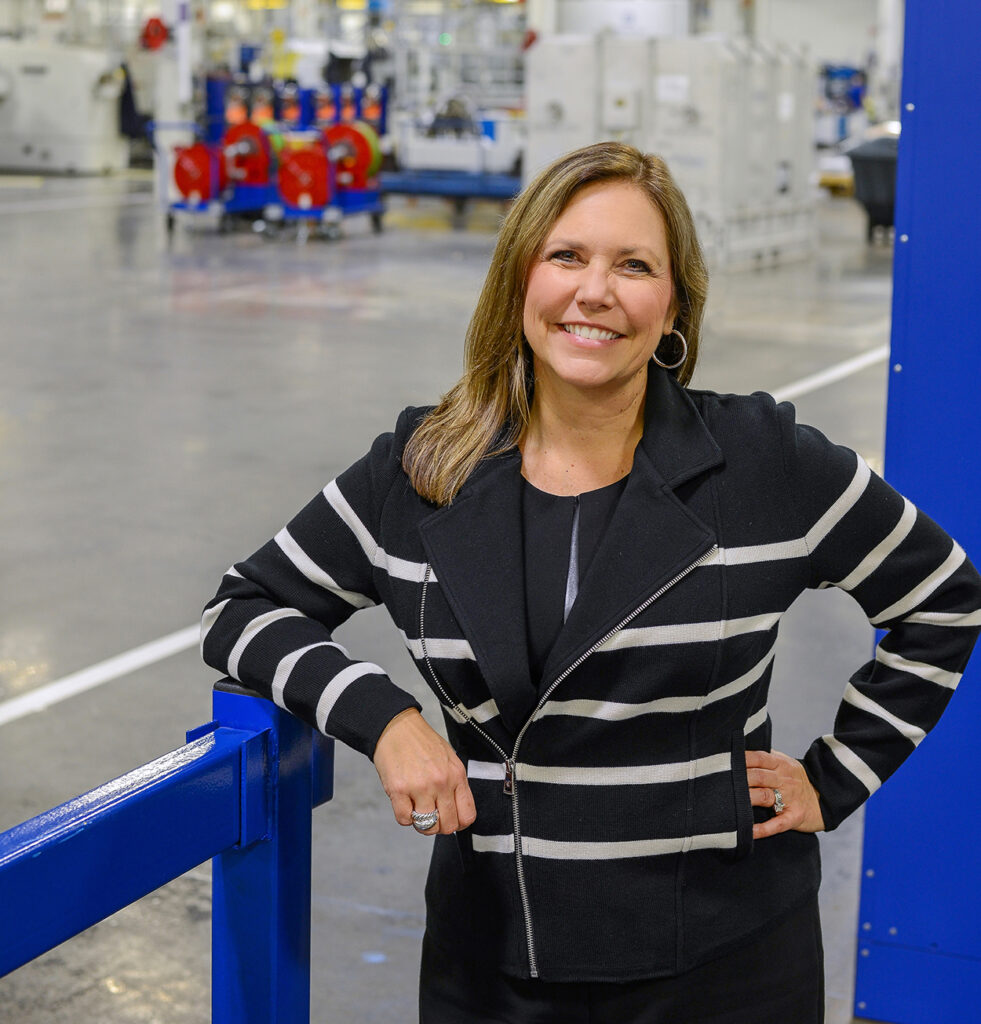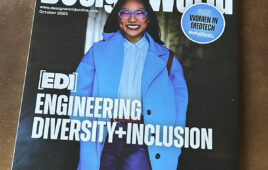Kathy Miller, Professional Coach & Business Transformation Advisor
Speaker/Author/ Sr. Manufacturing Executive,
Women in Manufacturing Hall of Fame Inductee (2021), most recently the Global Vice President of Vertiv Operating System
B.S. industrial systems engineering
For young students considering an engineering degree, going through a traditional engineering university is only one path. For professional engineers considering their career path, a degree in engineering is a springboard to a range of occupations, including consulting, as Kathy Miller shows.
Miller was a well-rounded student with good grades in all her classes. She could go in any direction she wanted. However, she did not have access to a college fund, so she put herself through college. The choices available to her included schools like Kettering University. Kettering offered a type of work and learn program where students would work six months a year, getting a range of practical experience, and then attend classes for six months.

“My education took five years,” she says, “but the great thing was I had this practical experience. Plus, I was able to come out of school with very little debt and get a really good job after. It was a practical decision rather than a passion decision.”
Even though she didn’t have role models for engineering, male or female, Miller chose industrial engineering because she liked the people and the processes.
“When I was a co-op student, I worked in industrial engineering in every single department in the factory, from labor relations through to taking noise surveys to ensure the environment was okay. I did a lot of layouts, moving things around the plant, as well as time studies to make processes more efficient and to balance the assembly line.
“After that, I moved into advanced engineering for instrumentation and audio systems. I worked on ergonomic issues associated with advanced displays. I was able to do a lot of exciting projects when I first got out of school. And then I went back into the plant.”
Miller enjoyed the tasks of fitting processes and equipment into a cohesive whole and learning the broader picture of how everything interacts in a manufacturing setup.
“It turns out that it was a wonderful background as my career progressed through manufacturing, which is where I chose to take it.”
Changing direction
Miller had a lot of interests in high school, including the humanities.
“After my post grad, I got a Master’s Degree in applied positive psychology. Well, if the truth be known, I wanted to study psychology out of high school.”
Engineering, though, was the practical choice, and it made it easier to find a job with a bachelor’s degree, ensuring a good living and enabling Miller to support herself.
Miller ran the plants at Rolls-Royce Defense globally and was promoted into leadership positions early in her career. She was a supervisor of an industrial design and mechanical engineering department in advanced audio systems.
“I was drawn to the people aspect of this position,” she says. My engineering degree was helpful for supporting the engineers … and providing an environment where they could flourish. We speak the same language, and I understood the challenges they faced and we worked on potential defects they saw in the designs.
“But part of me always wanted to study psychology. After the opportunities at Rolls-Royce, I decided I didn’t need any more operations experience. Life is short and I went back to school to pursue this degree. I felt that the hard work that I had done through the years and the results that I achieved afforded me the opportunity to live in choice and pursue that dream.”
The pursuit of her dream led to the publication of her book, Steel Toes and Stilettos. With the publication, Miller started a company with a friend, OPSisters. This is a coaching business that advises and helps manufacturing clients develop a roadmap to transform their businesses.

Steel Toes and Stilettos: A True Story of Women Manufacturing Leaders and Lean Transformation Success, (with S. Karels), published December 2021 by Routledge of Taylor & Francis Group. book image zoom screen-01
“Since my friend and I have spent the majority of our careers with manufacturing, it made sense. I’m coaching manufacturing leaders at all levels from team leaders through executive management. We have a class on creating lean transformations, and we help clients develop inclusive cultures.”
Miller did her thesis on manufacturing, titled Welcome to the Efficacious Factory. It focused on getting better business results through positive workplace relationships, optimism and meaningful work.
“I learned the science of organizational principles that help people flourish. Now, I have 117 pages of literature review connecting those concepts with business results. And I’ve got years of case studies. It’s a nice combination to help today’s modern factories. And manufacturing is undergoing a huge shift. Whether the industry likes it or not, it’s definitely changing.”
The new manufacturing reality
Miller sees a lot of variation on how companies adopt technology, how they include people, and how they treat their facilities. Plus, many manufacturing companies grow by acquisition, often purchasing the problems of the previous sites that now they must handle. Part of the problem is that the buying company attempts to impose its operating preferences on the bought company, leading to operational challenges.
Of course, the Pandemic has spotlighted many weaknesses and challenges of supply chains.
“Supply chain issues are always complex, depending on what your philosophy is,” she says. “I think right now, there’s been the normal challenges in supply chain, and then there’s the global pandemic. You’ve got workforce issues, the great resignation, company or countries turning on and off their supply chains, the lag between when you ordered things and when they’re available and when you shut down your purchase orders and… it’s just like this whole bullwhip effect. And I think it’s going to be a while before it stabilizes.”
What women bring to engineering
But such struggles can also be opportunities for women to “strut their stuff.” Miller says that there is a lot of research on what women bring to engineering problems and businesses. “Particularly as leaders, because women tend to promote cooperative learning versus competitive type cultural behaviors,” notes Miller.
“Women tend to be relationship oriented, so they can get better results from a group versus an individual project. And diversity of thought is so important for getting the most creative solutions.
“Every corporate culture is different, and there are subcultures within corporations that really do well. You can move from one part of a company to another and almost think that you’re in a different company. I always got great results by including everybody and making sure all voices were heard and giving everyone an opportunity to problem solve. When we had a recordable injury, I made all my staff go to the scene of the accident. Everyone had to contribute to the problem-solving process, even the marketing guy who didn’t want to go. And what you found was people just had different perspectives. My marketing executive came up with amazing solutions for things that he did outside of the plant that we could bring into the plant to help solve problems. So, I think that can be an advantage for female leadership, just that whole inclusivity.”
A woman in a man’s world
Women engineers can face challenges of working in a male dominated profession. And each woman handles it differently. Miller used her confidence to handle any situations that came up.
“I always felt that when I got a seat at the table, I had earned it. And I never really made gender an issue unless somebody else did. I grew up with brothers, went to engineering school, I was very comfortable in the male world. And unless someone made some sort of interesting comment, which happens, it wasn’t a big issue for me. I developed really strong relationships with male allies before they were even called male allies.
“What I would say is let your results speak for themselves. As I was leading plants, I just focused on doing a great job and getting great results. And then people would notice and they would come in and say, what’s Kathy doing? Her leadership teams are a little more diverse. Their rate of improvement is above average. Let your results be your calling card.”
Miller believes women should be encouraged to consider engineering. “Since the launch of the book, I’ve been doing a lot of podcasts and encourage women to go into STEM. I work with women in high tech, women in manufacturing. There are a number of different groups that I’m associated with. Everybody should consider it if they’ve got a propensity towards math and science, but we really want to encourage women to explore it.
“Some people don’t even consider engineering in the first place. It’s just not something that’s brought up in high schools. Particularly when you look at manufacturing, it’s not considered very glamorous. And thus, is not attractive to people. That’s why I try to get out and tell the stories of how I fell in love with the factory and in doing this.
“When I was at Rolls-Royce, we would sponsor grammar schools. We had problem solving projects for grammar schools. We would bring high schoolers in and take them on tours. They had some high-tech facilities that we were able to showcase.”
Unfortunately, keeping women in an engineering occupation is another challenge. Miller has read the studies that show that women don’t stay in the STEM fields very long. She sees that as something to focus on.
“For me, that means providing role models and mentors and allowing women to be authentically who they are. Women may approach things differently than their male counterparts. We shouldn’t make them conform to the male model; we should allow women to live in their strengths.
“We need to provide a support system to women engineers. If they’re the only token female in a male engineering group, someone needs to be an ally to that person. If you are a female, you need to be a role model to other women in your company. I didn’t have female role models. There weren’t many women in manufacturing leadership, or engineering leadership that I had exposure to. So, I had to pave my own way. Ladies in these companies need to reach into the organization and provide support as well as model what it can be to be a successful engineer without giving up your identity. You don’t have to conform to male stereotypes to be successful. And there needs to be male allies who will speak up for them. If a woman’s voice is getting run over by men, the male allies need to call that out and move attention back to the woman.”
Studies show that when women advocate for themselves, it’s not accepted as widely as when men advocate for them, which is unfortunate, but for whatever reason, it appears to be true.
“Also, management needs to ensure their women engineers get good assignments and work in ways that contribute to the organization. I know when I was in engineering, I worked on many special projects that were beyond the technical aspect of the job. I helped put in a mentoring program. I helped some of the male engineering leaders who were technically astute but had people issues.”
Corporate management has work to do. The traditional pathway to managerial or supervisory roles is so male dominated in perspective that people forget about the people issues. “Some people should never be a manager, even though they’re technically brilliant,” notes Miller. “Some people should absolutely go up because they have better people skills.
Final thoughts
Miller advises women who find engineering rewarding, but frustrating, to focus on two things. “First of all, develop strong relationships within the organization regardless of people’s gender. I had a lot of amazing male coaches, male mentors, male bosses along the way who are not misogynistic, or just who are amazing leaders. So I don’t want to characterize what I said as being all females have this and all males don’t. It doesn’t work that way.
“And when you’re problem solving, make sure you go to the root of the problem, sort emotion from fact and go where things are happening and you’ll get better results. And the results will come. Let them speak for themselves and you’ll be just fine.”
Filed Under: Engineering Diversity & Inclusion




